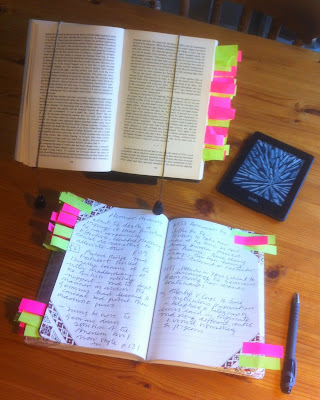Fig.1. My Personal Learning Environment
For someone who completed the Master of Arts Open and Distance Education over a year ago and has done further MAODE modules here and other MA modules elsewhere it surprises even me to recognise I learn, and probably do, more when I am NOT in front of the computer (iPad, laptop or desktop).
These days I have no choice but to read books and when I do this is how I set about them:
Read and attach PostIts
Write up, selectively, into a notebook the bits that I've picked out (there is a further filtering process here)
Then type these notes up into a Google Doc (typically into a table).
I have become meticulous about citing as I go along as to want to use a quote or idea and not know where it came from can take a considerable time to recover.
An eBook isn't only on the Kindle (now Paperwhite), but also on the iPad and sometimes even on the laptop or desktop. I read in tight columns with few words, fast - like a TV autocue. As I go along I highlight. Sometimes bookmark something important or big. And from time to time add a note. On other screens the highlights can be colour sorted, so I may theme these as highlights for an essay, for their narrative value, or simply their quirkiness (so I can blog about it).
Interaction with the content in any and many ways is key. Having a presentation to give or essay to write is crucial, otherwise you can read a book and highlight/bookmark far too much of the thing.
Invariably I follow up references. I may loop off to read parts of these references immediately, which may be a paragraph in another book, sometimes a book I can find free online, sometimes an eBook for £2 or so ... occasionally a hefty tome that gives me pause for thought. I have a student library card so can get down to the University of Sussex in 30 minutes. Here I've just read a few chapters from a biography on Plumer as I'm preparing something on aspects of Third Ypres, the Battle of Passchendaele. My self-directed reading list my have expanded to some dozen texts by now: divisional histories, several biographies on Haig, several books on military history with specialist books on the machine gun corps and gas. My notes are always created in Google Docs and in this case the folder shared with a fellow student who has added his own notes too. The learning process is akin to making a sculpture out of papier mache - I keep attaching little pieces and am starting to get a clear idea of the thing.
Is reading still one of the most efficient ways to pass information from one person/source to another? It's quicker than a lecture. Good for many things. Were I studying Law surely reading is everything, whereas Chemistry or Physics you may benefit from and prefer the video/animation, the lecture with charts.

